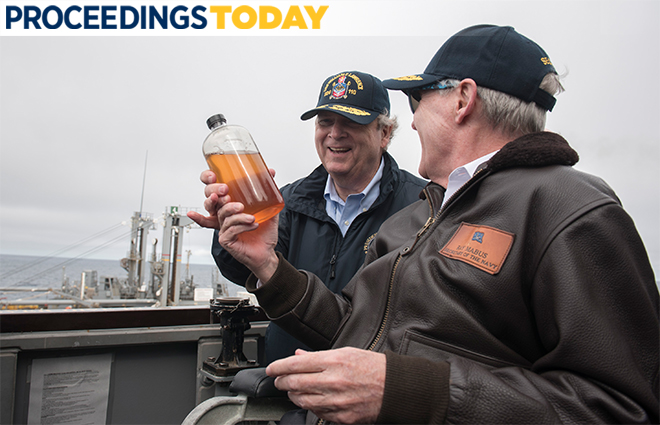
In 2011, then-Secretary of the Navy Ray Mabus announced an initiative called the Great Green Fleet. Although wrapped in the mantle of warfighting, it was never really about the Navy. Instead, it was about pursuing a national energy agenda and using military money to create a biofuel industry. The Great Green Fleet became part of a broader set of initiatives designed to put the Navy on the front lines of the fight against climate change. Although superficially plausible at the time when fuel prices were high, the Green Fleet is inappropriate, even counterproductive, at a time of booming U.S. energy production and Navy budget shortfalls. It is time to take a critical look at these energy initiatives, terminate those that do not directly help the Navy, subject others to cost-benefit analysis, but also look broadly at places where additional energy investments might help the Navy.
The Great Green Fleet was the most egregious element of the former secretary’s energy initiatives. Biofuels—making fuel from biological matter rather than pumping it from the ground—were thought to be more environmentally friendly and a way to reduce dependence on foreign oil. The administration committed to a half-billion-dollar initiative to jumpstart the industry, of which the Navy was responsible for $150 million. The Navy let contracts to various biofuel startups and development companies, bought developmental biofuel, and ran tests to ensure that these fuels were compatible with Navy systems. Critics said the Navy was paying $27 a gallon for biofuel when it could buy regular fuel on the open market for under $3 a gallon (see Commander James A. Corletta’s “It’s Not So Easy Being Green,” November 2014, Proceedings). The secretary argued that creating a biofuel industry would expand fuel sources for the Navy in a crisis. Critics pointed out that Navy fuel requirements were a minor amount of national consumption (0.5 percent) and this additional source was unnecessary. A 2010 RAND study found “no benefit” to alternative fuels.
The drive for sustainable energy has spawned a wide variety of wind and solar projects on naval facilities. Without question, these efforts produce energy so bases no longer need to buy from the civilian grid. Whether the savings justify the large upfront investment costs is unclear. (One Norfolk project had a payback period of 448 years, according to a Department of Defense Inspector General audit in 2011.)
“Net zero” bases (energy, water, and waste independence from the civilian infrastructure) is one of those trendy ideas that makes little sense in the real world. Military bases do need the ability to operate services, particularly those supporting vital warfighting functions, for short periods of time if something happens to civilian infrastructure. But making entire bases independent of the broader economy is expensive and unnecessary.
Creating new fuel sources was never necessary, but it is ludicrous now. Fracking and other technologies have skyrocketed U.S. production of oil and natural gas. The U.S. Energy Information Agency expects the United States to produce more crude oil in 2018 (9.9 million barrels per day) than it ever has in its history. The United States is now the largest hydrocarbon producer in the world, surpassing Russia and Saudi Arabia, having increased its production by 50 percent in the last decade. Global oil prices have plummeted, from $140 per barrel to about $50 per barrel.
The Navy and Marine Corps are facing severe budget trade-offs and cannot afford to divert funds to national energy projects. The Navy is trying to build to 355 ships, which the Congressional Budget Office estimates will cost an extra $5 billion per year for construction costs alone. Readiness is unacceptably low and needs a major funding boost.
So, what to do?
- Terminate the biofuel initiative. Let the energy market decide whether biofuels are a viable source of future energy.
- Review all Navy energy production projects, both past and proposed, to determine whether the investment justifies the savings. The cost of photovoltaic cells has been dropping and wind energy has been gaining in the energy market even without subsidies.
- Continue efforts in operational energy. This is about getting energy to the right place on the battlefield with minimum warfighting risk, not about peacetime cost-effectiveness. An August Proceedings article attempts to defend the Great Green Fleet but mostly focuses on sensible energy efficiencies. (see Commander Daniel Orchard-Hayes’ and Lieutenant Colonel Laura King’s “Realize the Great Green Fleet,” August 2017, Proceedings.)
- Examine the areas where energy efficiency might have real economic benefits. The Navy has research-and-development projects in this area, such as jet engine efficiency. The classic investment, however, is heating and air conditioning systems. Upgrading these systems is not as exciting as building solar farms, but it often has big payoffs because the systems are used heavily but are often old and inefficient.
- Drop the “Green Fleet” terminology. There’s too much baggage with this term.
Colonel Cancian is the senior advisor to the International Security Program at the Center for Strategic and International Studies.
Photo caption: Former Secretary of the Navy Ray Mabus shows former Secretary of Agriculture Tom Vilsack a biofuel sample on board the USS William P. Lawrence (DDG-110) in 2016. This biofuel was made from waste beef fat and transferred from a fleet oiler to the destroyer as part of the Great Green Fleet initiative. The cost per gallon of this biofuel was much higher than conventional fossil fuels.


